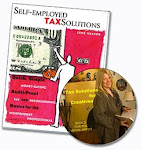I am getting lots of questions on estimated taxes, so I thought an overview necessary. Here 'tis.
Federal income tax, Social Security tax and Medicare tax are pay-as-you-go taxes; that is, the tax must be paid as income is earned. Dennis Dubya-two, shipping clerk for Toys 'n' Things, receives a paycheck every week. Each week Toys 'n' Things withholds all applicable taxes from Dennis’ pay and forwards them to various government agencies. At the end of the year Dennis receives a W-2 which shows income earned and taxes paid.
Self-employeds must follow the same pay-as-you-go method as do wage earners like Dennis. As an entrepreneur brings in income he withholds taxes from himself -- that is, he puts money aside -- and then sends his taxes to the government via estimated tax payments.
Not every self-employed has to make estimated tax payments.
It’s the overall tax liability of a self-employed that determines whether estimated tax payments are required. An indie’s total tax liability is made up of self-employment (SE) tax on his net self-employed earnings and income tax on all his and his spouse’s income.
SE tax and income tax on self-employed income are not the only factors in calculating estimated tax payments. If, for instance, you had a self-employed business income of $10,000 and also had investment dividends of $30,000, both these sources of income (totaling $40,000) would be elements in your estimated tax calculation. And if your wife earned $90,000 at her W-2 job, the taxes withheld from her income would also be a factor in those calculations.
Because someone is self-employed doesn’t necessarily mean that he must make estimated tax payments. Consider the following situations:
** When all income and deductions are combined, there is no tax liability. For instance, enough tax may be withheld via a W-2 job or pension withdrawals to cover the entire tax liability.
** The previous year’s tax refund may be carried forward in a sufficient amount to eliminate the need for estimated payments.
Who must make estimated tax payments?
Although there are exceptions, here's the safe and simple rule:
You must make estimated tax payments to the Federal government if you had a tax liability for the previous year and you expect to owe tax of $1,000 or more when you file your tax return for this year.
For more information on how to calculate estimated tax payments go to my site for Estimated Tax:How much should I pay?
When to make estimated payments:
Under most circumstances you will make four estimated tax payments to the IRS and also possibly to your resident state and, if you earn self-employed income elsewhere, to a non-resident state as well. The methods used to calculate the IRS estimated payment amount usually apply in the same way to the states – but to be sure you ought to confirm this with your tax preparer or state tax office.
The following shows the dates for making estimated payments.
For the period.............................Due date:
January 1 through March 31......April 15
April 1 through May 31...............June 15
June 1 through August 31..........September 15
Sept. 1 through Dec. 31.............January 15, the following year
It is not a crisis if you’re late on a payment due date. Depending on the amount of tax payment, an interest and/or penalty amount will be calculated at the time your tax return is prepared. The IRS rate is lower than most credit card finance charge rates.
How to pay estimated taxes:
There are several ways to pay estimated taxes.
Carry forward a previous year overpayment.
When you file your tax return, if you have an overpayment of tax you can choose to have the refund returned to you or you can apply part or all of it to your estimated tax for the following year.
The amount you have carried forward as payment toward the following year should be taken into account when figuring your estimated payments. You can use all the carry-forward amount toward your first payment, or you can spread it out in any way you choose among any or all of your payments. If you find the January 15 payment difficult because of holiday spending then use your carry-forward to ease your cash flow and have it applied to the fourth payment.
Pay by check.
Use Form 1040-ES, Payment Voucher, to pay Federal estimated tax. There are four numbered vouchers. Include one with each payment by check.
Be sure the voucher is filled in accurately. If you are married then put the names and Social Security numbers in the same order as they appear on your tax return.
Make the check or money order payable to the “United States Treasury.” On the check or money order write your Social Security number and “2007 Form 1040-ES.” Don’t staple or clip the check to the voucher.
If you made estimated tax payments in the previous year, you’ll receive IRS payment vouchers in the mail for the current year. You can get the vouchers and mailing address (it is not the same as that to which you mail your tax return) at www.irs.gov.
Careful! Never send a payment to the IRS (or any government agency) without the correct document – for example, a voucher-- properly filled out, accompanying it.
Pay by credit card, electronic payment or withdrawal.
Be careful if you pay your estimateds, or any other tax, by credit card. Most service providers charge a fee. This is in addition to any finance charges that will accrue, usually daily, on the amount you owe the credit card company. The options for credit card and electronic tax payments or funds withdrawal are changing rapidly. You can get the most current information at http://www.irs.gov/pub/irs-pdf/f1040es.pdf.
Estimated taxes are explained in greater detail in my book, Self-employed TAX Solutions.




